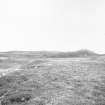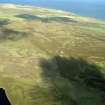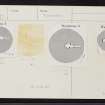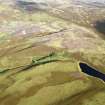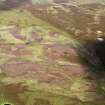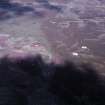Scheduled Maintenance
Please be advised that this website will undergo scheduled maintenance on the following dates: •
Tuesday 3rd December 11:00-15:00
During these times, some services may be temporarily unavailable. We apologise for any inconvenience this may cause.
Warehouse, East
Chambered Cairn (Neolithic)
Site Name Warehouse, East
Classification Chambered Cairn (Neolithic)
Alternative Name(s) Cairns Of Warehouse
Canmore ID 9078
Site Number ND34SW 69
NGR ND 30919 42324
Datum OSGB36 - NGR
Permalink http://canmore.org.uk/site/9078
- Council Highland
- Parish Wick
- Former Region Highland
- Former District Caithness
- Former County Caithness
ND34SW 69 30919 42324.
An Orkney-Cromarty type round cairn with a Camster-type chamber, one of the group of five cairns known as Cairns of Warehouse, it was excavated by Rhind in 1853 and Anderson in 1865. It is on the skyline of a moorland ridge at 150m OD, somewhat lower than Warehouse South (ND34SW 70) which is 400m to the SW. This cairn could have been given a more prominent site by building it on the rocky knoll immediately to the W. The rock lies in nearly horizontal strata, and close to the cairn it outcrops in several places through the thin peat cover. The cairn is covered by turf with many loose slabs exposed. The sides are steep and the edges are fairly well defined. It measures about 18m N-S by 16m E-W; it is 2m high on the S side, but due to the slope of the ground it is only 1.2m high on the W side. Within the cairn several large slabs on edge can be seen set more or less radially; the largest, 1.6m long, is shown on the plan. It is puzzling that after his brief investigation Anderson gave the dimensions of the cairn as only 9 by 7.6m. Presumably he found a wall-face on either side of the passage entrance and another about 1.5m behind the chamber; if so it is likely that the second wall-face was not part of the outer facing of the cairn but part of its internal structure. The entrance passage runs from slightly W of N. Anderson found it was 3m long and 0.76m wide. At present the E wall is visible for 2.3m, exposed for a height of 0.5m in five courses. A short stretch of the W wall can be seen near the outer end, and here the passage is barely 0.5m wide. Rhind found both the passage and chamber roofless and filled with stones. Ther was a pair of portal stones at the entry into the chamber, and two pairs of divisional slabs. From Rhind's plan it seems the chamber was about 4.2m long, the three compartments being about 1.1, 1.2 and 1.75m long. The walls of the outer compartment widened from little more than the width of the passage to about 1.5m at the maximum. The first pair of divisional slabs were no longer visible in 1865 when the chamber was described by Anderson as having two compartments. The short length of the E wall of the centre compartment shown on the 1952 plan by Miss Henshall can no longer be seen. At present only the inner compartment is visible, the back-slab 4.1m from the existing inner end of the passage. The compartment is 1.75m long by 1.6m wide at the maximum, and there is debris about 0.6m deep on the floor. The inner W divisional stone is 0.5m long. 0.1m thick and exposed for a height of 0.6m. The W wall is of oversailing masonry, in poor condition and falling away in places, but it still stands to a maximum height of 0.9m above the debris on slab, but only to,level the floor. The back-slab is 1.1m long, 0.15m thick and 0.5m high above the debris. The E wall is partly constructued of a slab on edge set 0.4m from the back-slab. This wall slab is 0.95m long, 0.05m thick but obviously reduced by flaking and exposed for a height of 0.2m. Walling of small slabs remains above its S end and also on the sloping shoulders of the back-slab, but only to level with its top. Two large slabs, probably displaced divisional slabs, lie in the chamber. Rhind found in the inner and centre compartments 'the most insignificant, ... untangible (sic) vestiges of bones', On the W side of the chamber, on either side of the first divisional slab, were two crushed skulls, and he thought the bodies had 'probably stretched along in opposite directions'. Part of a third skull was found beside the first E divisional slab, and part of an upper jaw lay in the passage. All the human remains are now lost.
Visited by A S Henshall 22 June 1952; J L Davidson and A S Henshall 20 September 1985
J Rhind 1854; J Sinclair 1865; J Anderson 1886; RCAHMS 1911; A S Henshall 1963; R J Mercer 1985; J L Davidson and A S Henshall 1991.
Scheduled with ND34SW 41, ND34SW 70, ND34SW 71 as Cairns of Warehouse.
Information from Historic Scotland, schedulking document dated 9 November 2000.
This grass-grown chambered cairn lies in heather moorland and commands extensive views N to the Loch of Yarrows. It measures 16.5m from NNW to SSE by 14.2m transversely and stands to 3m in height on the SSW. Here, some large loose stones lie exposed, and on the S one slab is visible set upright within the body of the cairn at right angles to its edge. The entrance to the chamber leads into the cairn from the NNW, forming a linear hollow with a stretch of wall 2.4m long and 0.4m high along its ENE side, beginning 3.2m from the outer edge of the cairn. The passage is roofless, but several large flagstones lie adjacent and may have been lintels. Only the WSW divisional stone at the rear of the chamber remains standing, and is linked by walling to the large slab that rises from the floor and forms the rear of the chamber.
(YARROWS04 420)
Visited by RCAHMS (ARG) 28 July 2004



























